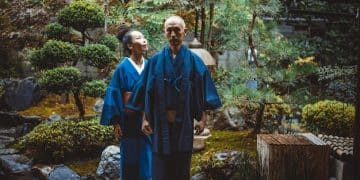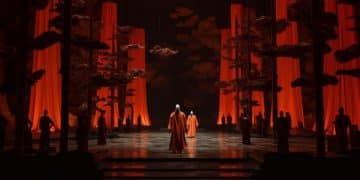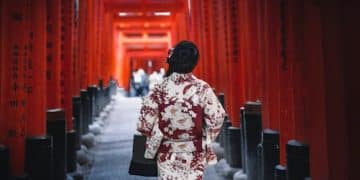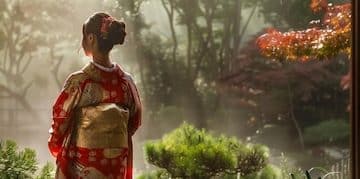Unlocking Cultural Depths: Understanding Japanese Drama Traditions & Customs
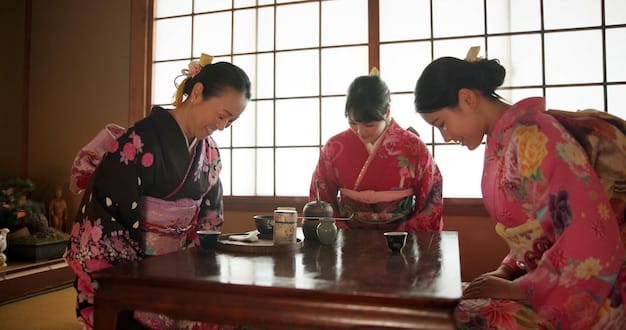
Advertisements
Japanese drama cultural references enrich the viewing experience by offering insights into traditions, customs, and societal values, providing a deeper understanding of Japanese culture and context.
Japanese drama cultural references are windows into the soul of Japan, offering a vibrant tapestry of traditions, customs, and societal values that enrich storytelling and provide viewers with a deeper understanding of Japanese life.
Anúncios
The Essence of Japanese Culture in J-Dramas
Japanese dramas, often called J-dramas, are not just entertainment; they are cultural artifacts that reflect and shape Japanese society. Understanding the cultural references within these dramas is essential for appreciating their depth and significance. These references range from subtle gestures and honorifics to elaborate festivals and historical events.
By exploring these embedded cultural references, viewers can gain insights into the values, beliefs, and social norms that underpin Japanese society. This exploration enhances the viewing experience and fosters a greater appreciation for the richness and complexity of Japanese culture.
Anúncios
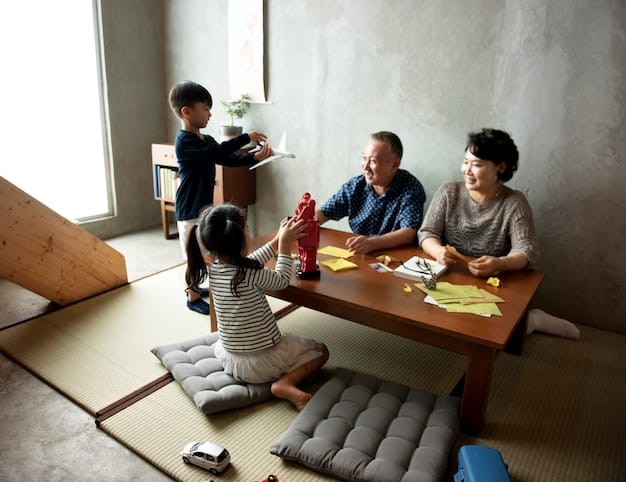
Understanding Japanese Customs Through Drama
One of the easiest ways to learn about Japanese culture is by immersing yourself in Japanese media. J-dramas are a very popular choice as they offer a wide range of situations and customs to be introduced to.
- Greetings and Bowing (Ojigi): The depth and angle of a bow convey respect and social status, with deeper bows indicating greater deference.
- Gift-Giving (Omiyage): Gift-giving is a common social ritual. Choosing the right gift, the way it is presented, and even the timing can be important indications of gratitude and thoughtfulness.
- Family Structure: J-dramas show the importance of familial hierarchy. Respect for elders and the roles of family members are often central themes.
Common customs such as removing shoes before entering a home or understanding the seating arrangements at meals have cultural significance. These everyday practices reflect a deep-seated respect for cleanliness, order, and hierarchy.
Traditions That Shape J-Drama Narratives
Traditions play a central role in many J-drama storylines. These traditions often act as barriers or catalysts for character development, adding layers of complexity to the plot. The clash between tradition and modernity is a recurring theme, particularly in dramas that deal with family expectations or social change.
Understanding the historical context and the evolution of traditions helps viewers appreciate the nuances of these conflicts. J-dramas excel at portraying the emotional weight of these cultural expectations, providing a nuanced perspective on the challenges of balancing tradition with personal desires.
Festivals (Matsuri) and Seasonal Events
Festivals are an integral part of Japanese culture, and they frequently feature in J-dramas. These events serve as colorful backdrops and also provide opportunities for character interactions and plot development.
Seasonal events like cherry blossom viewing (Hanami) and New Year celebrations (Shogatsu) are depicted to showcase the beauty of nature. They provide a sense of continuity and cultural identity.
Traditional Arts and Practices
J-dramas frequently incorporate traditional arts such as tea ceremonies (chado), calligraphy (shodo), and flower arrangement (ikebana) to illustrate aspects of Japanese aesthetics and spirituality.
- Tea Ceremony (Chado): Symbolizing harmony, respect, purity, and tranquility, the tea ceremony is often depicted as a meditative practice.
- Calligraphy (Shodo): Calligraphy showcases the elegance of Japanese writing.
- Flower Arrangement (Ikebana): The art of ikebana illustrates a deep connection with nature.
These practices reveal deeper cultural values related to mindfulness, discipline, and the pursuit of beauty in everyday life. They show the aesthetic principles that guide Japanese artistic expression.
Social Hierarchies and Etiquette
Japanese society is deeply structured, and J-dramas often reflect this through character interactions and dialogue. Understanding social hierarchies and etiquette is vital for grasping the subtleties of these dramas. Honorifics, forms of address, and non-verbal cues signal relative social status and influence the dynamics between characters.
The language used in J-dramas is highly nuanced, with different levels of politeness (keigo) used depending on the relationship between speakers. Misunderstandings in social interactions can generate tension and drive the plot forward. By paying attention to these linguistic and behavioral cues, viewers can gain a deeper appreciation of the carefully constructed social world within the drama.

The Significance of Honorifics
Honorifics, such as “-san,” “-sama,” “-kun,” and “-chan,” indicate varying levels of respect and familiarity. The use of these suffixes is not arbitrary; it reflects the social distance between individuals and the nature of their relationship.
Workplace Dynamics and Respect for Seniors (Senpai-Kohai)
Workplace dramas often highlight “senpai-kohai” relationships, where senior colleagues mentor and guide junior ones. This system reinforces the value of experience and apprenticeship in Japanese professional culture.
Historical Context and Period Dramas (Jidaigeki)
Historical dramas, known as Jidaigeki, provide a window into Japan’s past, portraying significant events, cultural transitions, and historical figures. These dramas offer a rich tapestry of feudal Japan. They often deal with themes of honor, duty, and sacrifice. By watching Jidaigeki, viewers can learn about the historical events that have shaped Japanese identity and social norms.
Samurai Culture and Bushido
Samurai culture, with its emphasis on Bushido (the way of the warrior), appears frequently in Jidaigeki. Dramas explore the ethical codes and values of the samurai class, highlighting their loyalty, courage, and self-discipline.
Even in contemporary J-dramas, the spirit of Bushido can be seen. In these dramas, the themes of perseverance, honor, and commitment to duty can be seen throughout.
The Meiji Restoration and Modernization
Dramas set during the Meiji Restoration period (1868-1912) often depict the rapid modernization of Japan and the clash between traditional values and Western influences.
- Social Change: The introduction of Western clothing, education systems, and legal frameworks challenged established social norms.
- Cultural Preservation: J-dramas often portray the struggles to balance modernization with the preservation of Japanese cultural identity.
Religious and Spiritual Elements
Religion is woven into the fabric of Japanese culture, and Shinto and Buddhism are prominent influences that also show up in J-dramas. These beliefs influence everything from daily rituals to major life decisions. Shinto, with its reverence for nature and ancestral spirits (kami), highlights the interconnectedness of all things. Buddhism emphasizes compassion, mindfulness, and the pursuit of enlightenment.
Supernatural elements, such as ghosts (yurei) and spirits, are common in J-dramas, especially in the horror and mystery genres, reflecting Japan’s rich tradition of folklore and spiritual beliefs.
Shinto Shrines and Buddhist Temples
Shinto shrines and Buddhist temples are ubiquitous in J-dramas. They serve as places of worship, reflection, and solace. These sacred spaces often provide a backdrop for significant events in the lives of the characters.
Supernatural and Mystical Themes
Folklore and mythology frequently appear in J-dramas, adding layers of depth and intrigue to the narratives. Beliefs like Kami, Yokai and Yurei are woven into the narratives.
- Ghosts (Yurei): Ghosts remind viewers of unresolved issues and the importance of closure.
- Spirits (Kami): Spirits show the reverence for nature and ancestral spirits.
- Yokai: Yokai are supernatural creatures, often causing mischief or offering wisdom.
Modern Interpretations and Contemporary Issues
While J-dramas often celebrate traditional culture, they also address contemporary social issues such as workplace stress, family dysfunction, and the challenges faced by marginalized communities. These modern interpretations reflect Japan’s ongoing evolution and its efforts to grapple with complex social realities.
By exploring these issues, J-dramas provide a platform for dialogue. They can raise awareness about important social challenges within Japanese society today. They challenge viewers to think about their own biases and assumptions.
Addressing Social Issues
J-dramas often tackle difficult topics such as bullying (ijime), suicide, and mental health, shedding light on issues that are often stigmatized in Japanese society.
The Role of Women in Modern Japan
Many J-dramas explore the changing roles of women in contemporary Japan, depicting their struggles to balance career aspirations with traditional expectations.
| Key Topics | Brief Description |
|---|---|
| 🎎 Traditions | Traditions such as tea ceremonies and festivals are integral to storylines. |
| 🧑🤝🧑 Social Hierarchies | Honorifics and workplace dynamics reflect strict social structures. |
| ⛩️ Religion | Shinto and Buddhism influence daily rituals and spiritual themes. |
| 🏢 Modern Issues | Contemporary dramas tackle workplace stress and family issues. |
Frequently Asked Questions
▼
Cultural references enrich storytelling by adding depth and context to the narrative, allowing viewers to understand the underlying social norms and values that drive the characters’ actions. This enhances the viewing experience.
▼
J-dramas depict traditional Japanese values through customs, rituals, and social interactions. These portrayals educate viewers about the importance of family, respect for elders, honor, and harmony in Japanese society.
▼
Festivals serve as vibrant backdrops for character interactions and plot development. They highlight seasonal changes and cultural celebrations. This helps viewers understand the rhythm and traditions of Japanese life.
▼
J-dramas tackle tough social issues like bullying, mental health, and gender inequality. This often sparks dialogue and raises awareness. They can challenge societal norms and promote discussions about change.
▼
Viewers can learn about key historical eras and events from J-dramas, such as the feudal period and the Meiji Restoration. These can provide insights into the societal shifts and cultural developments in those periods.
Conclusion
Understanding Japanese drama cultural references provides viewers with a richer, more immersive experience. By exploring traditions, customs, and social norms depicted in J-dramas, you gain a deeper appreciation for the depth and complexity of Japanese culture, enhancing both your entertainment and your understanding of Japan.
